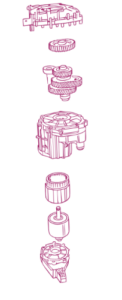(R)EVOLUTION - Hybrid powertrain
Hybrid powertrain – The rebirth of an old concept
Hybridisation occupies a central place among the major technological revolutions that have shaped the modern automobile. It represents a turning point where manufacturers have managed to reconcile two requirements long perceived as contradictory: performance and energy efficiency. By combining a combustion engine with an electric motor, hybrids are paving the way for more rational and environmentally friendly mobility.
Although the idea is not new – as early as 1894, French inventor Paul Pouchain had already imagined a vehicle combining a petrol engine and electric motors – it took more than a century for it to be truly realised on an industrial scale. In 1997, Toyota launched the Prius, the first mass-produced hybrid car. With it, hybridisation moved from the laboratory to the road, demonstrating to the general public that it was possible to significantly reduce fuel consumption and pollutant emissions without sacrificing range or performance.
The principle is based on the intelligent management of two energy sources. In the city, at low speeds, the electric motor takes over to provide quiet driving with no local emissions. On the open road or when accelerating, the combustion engine kicks in, supported by the electric motor during periods of high demand. The two engines work together, managed by sophisticated electronics that optimise each phase of driving. All the driver notices is the comfort of a smooth and efficient ride.
The success of the Prius paved the way for a multitude of variations. Plug-in hybrids, which appeared in the 2000s, add the possibility of recharging the batteries from the mains, increasing the range in pure electric mode. This development has brought the car even closer to 100% electric power, while reassuring drivers with the presence of the combustion engine.
Today, hybridisation has established itself as a transitional technology, a bridge between the era of traditional combustion engines and that of electric mobility. It is used in a wide range of vehicles, from city cars to SUVs, and illustrates the automotive industry’s ability to innovate in the face of energy and environmental challenges.
More than just a technical solution, hybrid technology has become a symbol of intelligent compromise: a technology that meets both drivers’ expectations and sustainability requirements. Its history also reminds us that many pioneering ideas – such as those of Paul Pouchain at the end of the 19th century – sometimes only come to fruition much later, when the technical and societal conditions finally align.



